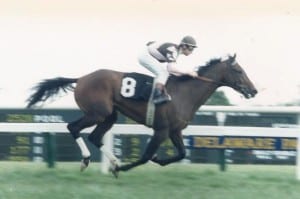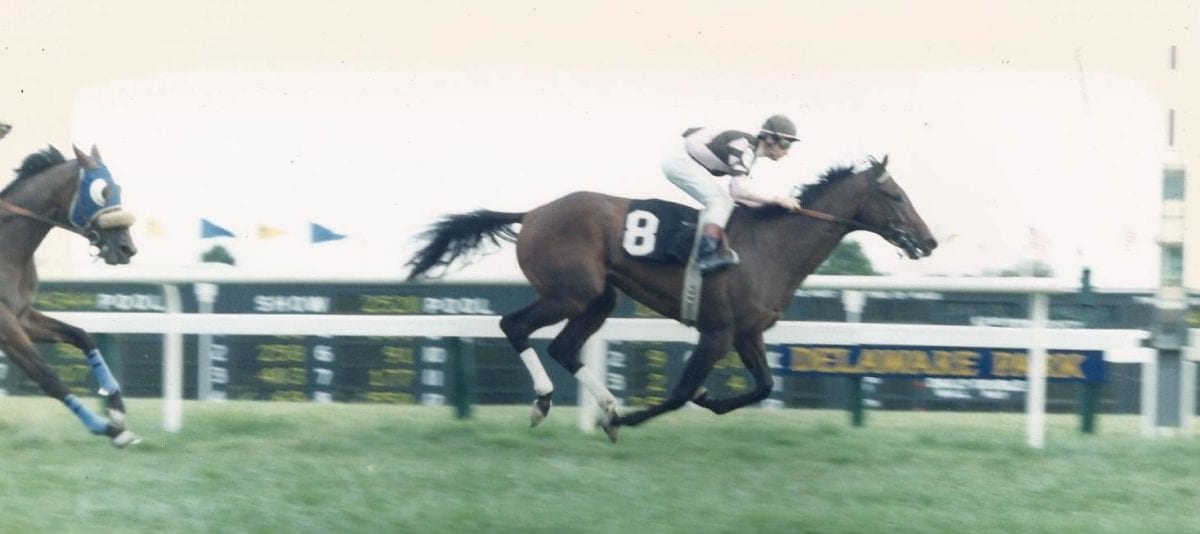
Highland Springs won 13 races, three graded, and more than $400,000. Photo courtesy of George Rowand.
by George Rowand
Breeding stakes winners – and particularly graded stakes winners – is the ultimate aim for most breeders in the Sport of Kings. Yet if someone with the audacity to say that they can show you how to breed stakes winners shows up on your doorstep – or on a website that you regularly read – I’d say that you are free to dismiss their ideas out of hand.
Still.
Breeding stakes winners is a supremely challenging endeavor, particularly for those with limited resources, yet small breeders foal stakes winners all the time.
I know. It happened to me.
I got into the horse business with the intention of buying yearling fillies, racing them successfully and then turning them into broodmares. That plan went out the window almost immediately.
We bought three fillies our first two years in the business. The first, Toujours l’Audace, by Intrepid Hero out of Vapors, by Swoons Son, retired to the breeding shed when she was three, without having made a start. The third, Fragile Dream, by Turn and Count and out of Silent Choice by Silent Screen, also never made a start.
In between them came Highland Mills, by Pia Star and out of Le Moulin by Hawaii. She got to the track, but the pressure of getting racing fit got into her head too much, and we had trouble keeping weight on her. She would wash out in the paddock before a race and then show early speed before quitting in the stretch of sprint races. Her racing career encompassed five starts, and her past performances looked like this: seventh, seventh, third in a 4-furlong race at Timonium, seventh, and 10th and last in her final start. Her earnings totaled $450.
Since she’d actually reached the track, she became known as our “good” mare. So that’s where we started, with three broodmares, none of whom had ever won a race, and including two that had never even gotten to the track. We started out breeding them to inexpensive stallions …$2,500, $3,500, $6,500 and so forth.
If I stopped right there and let you think about our breeding prospects for a moment, I suspect that your mind would say, “Well, that won’t work.” And you should be right because half of the equation of the foals that we were breeding – the broodmares – were completely unsuccessful as racehorses, and the other half – the cheap stallions — had been moderately successful racehorses, so, if one averaged the two parents, the resulting foal should be somewhere between cheap claimer and completely useless.
Yet breeding any animal is not an exact science. When you’re throwing the genetic dice, you can never be certain what will show up. And that’s what makes racing so interesting. You just never know where the next good horse is going to come from. It might just be your next foal. For us, it was the first pop out of the box from our “good” mare.
This leads me to my first – and most important – bit of advice: understand your mare.
[pullquote]When you’re throwing the genetic dice, you can never be certain what will show up. And that’s what makes racing so interesting.[/pullquote]Unlike the other two mares we owned and were breeding, the “good” mare provided me a race record to scrutinize. Our trainer said that Highland Mills was “cheap speed,” and he was right. She was quick out of the gate, often attended the early pace, but she was finished after a half-mile. Her racing career screamed “Sprinter!”
But her pedigree was saying something else entirely. I went back and looked at every mare in her pedigree as far back as records would take me, and I discovered something interesting: the family was a late-maturing family that had been bred for longer, even classic distances. It was an old Claiborne Farm family, and when I looked at every foal in five or six generations of the family, I saw that only a tiny handful had won at 2. So I knew that one of my challenges was to move the family “forward” a bit, to add some early maturation, if I could.
Close up, I saw that the dam of our mare had been stake-placed in some small stakes races in California. But when I looked at every race that she had run, I saw that she had run very well against some big-name mares in bigger stakes races in California. That told me that her racing ability probably was better than her record. It also told me that her best racing distance appeared to be 1 1/16th miles on the grass.
Highland Mills’s sire, Pia Star, was a miler who had beaten decent horses in New York. It appeared that – in terms of pedigree – our mare really wanted to run a distance of at least a mile.
Here’s what I thought I had in our mare: a late-maturing speed horse with a distance pedigree who could run about a half-mile. It was an odd combination of traits.
Given that, I tried to find a stallion for under $7,500 that could make up for her deficiencies. I wanted to find a stallion that had won at 2, but who had also won later and at longer distances: an early-maturing distance horse. That, of course, was a challenge of the first order as generally, early-maturing horses tend to be sprinters — exactly what I didn’t want.
I looked at every stallion in the area that stood for $7,500 or less, and I found one that I really liked. He won at two, and he won at three. He won at five furlongs, and he won at nine furlongs. He won on the dirt, and he won on the grass. Plus his pedigree had a stallion I liked that was in our mare’s pedigree. I wanted to double up on that, if I could. And he stood for $3,500.
His name was Lucy’s Axe, and I called the farm to see if I could breed to him. When they said, “Yes,” I was awash in happiness. I suspect that I was the most excited person to ever breed a mare to him.
When the foal, whom we named Highland Springs, arrived, he was – in the parlance of the breeding game – “just a horse.” There was nothing special about his looks. He bucked shins twice at 2, and when he went to the track at 3, our trainer thought he might be worth $18,500 or so, which seemed like a pretty good return on a $3,500 stud fee.
He lost his first start – running 7th, just like his dam – so we dropped him into a $6,500 maiden claimer at Pimlico. He won. Then he won again, and again and again, ascending the ladder to the $25,000 claiming level. By the end of the year, he had won a small allowance race.
[pullquote]This leads me to my first – and most important – bit of advice: understand your mare.[/pullquote]The next year, after being on the sidelines for nine months for a knee operation, he came back better. Then, when he was 5 – it is a later-maturing family, remember – he really got going. He ran second in a stakes race on the turf at Pimlico before running off three straight stakes wins at Laurel and Saratoga, setting a stakes record in the $150,000 Grade 3 Saratoga Budweiser Breeders’ Cup, in which he covered 1 1/16 miles on the turf in 1:39 1/5. He ended up running in the $1 million Breeders’ Cup Mile, where he was head-and-head for the lead at the eighth pole when the jock dropped his whip as he was changing hands. He was beaten two lengths for everything.
When all was said and done, he retired as a multiple graded-stakes winner of over $400,000.
Try to count the horses that you have seen break their maiden for $6,500 who went on to become graded stakes winners and run in the Breeders’ Cup. I suspect you won’t get off the fingers of one hand.
Amazingly enough, there was more to come.








